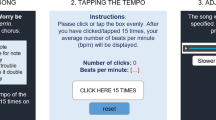Abstract
Performance on spatial rotation tasks has been shown to improve following listening to music that one likes with the explanation that the fast tempo, and the major mode associated with it, increases arousal and mood. However, given that research also shows that people sometimes like slow-tempo music as much as fast-tempo music it seems remiss that this preference effect has not been explored for slow-tempo music. We extend previous findings by using a more ecologically-valid method and explore whether the tempo effect was independent of the preference for the music, especially when the music is of a slow tempo. Participants listened to both liked and disliked music, in either a fast or slow tempo, prior to completing a series of spatial rotation tasks. In both tempos, liked music was associated with significantly better spatial rotation performance than disliked music. Interestingly, disliked, fast-tempo music was no better than liked, slow-tempo music. Results are discussed with respect to the arousal and mood literature.


Similar content being viewed by others
References
Ali, S. O., & Peynircioğlu, Z. F. (2010). Intensity of emotions conveyed and elicited by familiar and unfamiliar music. Music Perception, 27, 177–182.
Allport, A., Antonisa, B., & Reynolds, P. (1972). On the division of attention: a disproof of the single channel hypothesis. The Quarterly Journal of Experimental Psychology, 24, 225–235.
Balch, W. R., & Lewis, B. S. (1996). Music-dependent memory: the roles of tempo change and mood mediation. Journal of Experimental Psychology: Learning, Memory and Language, 22, 1354–1363.
Cassileth, B. R., Vickers, A. J., & Magill, L. A. (2003). Music therapy for mood disturbance during hospitalization for autogolous stem cell transplantation: a randomized controlled trial. Cancer, 98, 2723–2729. doi:10.1200/JCO.2005.11.922.
Chabris, C. F. (1999). Prelude or requiem for the “Mozart effect”? Nature, 400, 826–827.
Fox, E. (2008). Emotion science: cognitive and neuroscientific approaches to understanding human emotions. Hampshire: Palgrave Macmillan.
Gerardi, G. M., & Gerken, L. (1995). The development of affective response to modality and melodic contour. Music Perception, 12, 279–290.
Halpern, D. F. (1992). Sex differences in cognitive abilities (2nd ed.). Hillsdale: Erlbaum.
Hebb, D. O. (1955). Drive and the CNS (conceptual nervous system). Psychological Review, 62, 243–354.
Hetland, L. (2000). Listening to music enhances spatial-temporal reasoning: evidence for the “Mozart effect”. Journal of Aesthetic Education, 34, 105–148.
Husain, G., Thompson, W. F., & Schellenberg, E. G. (2002). Effects of musical tempo and mode on arousal, mood, and spatial abilities. Music Perception, 20, 151–171.
Jones, D. M. (1999). The cognitive psychology of auditory distraction: the 1997 BPS Broadbent lecture. British Journal of Psychology, 90, 167–187.
Jones, D. M., & Macken, W. J. (1993). Irrelevant tones produce an irrelevant speech effect: implications for phonological coding in working memory. Journal of Experimental Psychology: Learning, Memory, and Cognition, 19, 369–381.
Jones, D. M., & Tremblay, S. (2000). Interference in memory by process or content? A reply to Neath (2000). Psychonomic Bulletin and Review, 7, 550–558.
Kimura, D. (1996). Sex, sexual orientation and sex hormones influence human cognitive function. Current Opinion in Human Neurobiology, 6, 259–263.
Krumhansl, C. L. (1997). An exploratory study of musical emotions and psychophysiology. Canadian Journal of Experimental Psychology, 51, 336–353.
Nantais, K. M., & Schellenberg, E. G. (1999). The Mozart effect: an artefact of preference. Psychological Science, 10, 370–373.
Perham, N., Banbury, S. P., & Jones, D. M. (2007). Reduction in auditory distraction by retrieval strategy. Memory, 15, 465–473.
Perham, N., Marsh, J. E., & Jones, D. M. (2009). Syntax and serial recall: How language supports memory for order. Quarterly Journal of Experimental Psychology, 62, 1285–1293. doi:10.1080/17470210802635599.
Perham, N., & Sykora, M. (2012). Disliked music can be better for performance than liked music. Applied Cognitive Psychology. doi:10.1002/acp. 2826.
Perham, N., & Vizard, J. (2010). Can preference for background music mediate the irrelevant sound effect? Applied Cognitive Psychology, 25(4), 625–631. doi:10.1002/acp. 1731.
Power, M. J., & Dalgleish, T. (2008). Cognition and emotion: from order to disorder (2nd ed.). Hove: Taylor Francis.
Rauscher, F. H., Shaw, G. L., & Ky, K. N. (1993). Music and spatial task performance. Nature, 365, 611.
Rickard, N. S., Toukhsati, S. R., & Field, S. E. (2005). The effect of music on cognitive performance: insight from neurobiological and animal studies. Behavioural and Cognitive Neuroscience Reviews, 4, 235. doi:10.1177/1534582305285869.
Salamé, P., & Baddeley, A. (1989). Effect of background music on phonological short-term memory. The Quarterly Journal of Experimental Psychology, 14, 107–122.
Schachter, S., & Singer, J. E. (1962). Cognitive, social and physiological determinants of emotional state. Psychological Review, 69, 379–99.
Schellenberg, E. G. (2005). Music and cognitive abilities. Current Directions in Psychological Science, 14, 322–325.
Schellenberg, E. G., Peretz, I., & Vieillard, S. (2008). Liking for happy- and sad-sounding music: effects of exposure. Cognition and Emotion, 22, 218–237.
Schlittmeier, S. J., Hellbrück, J., & Klatte, M. (2008). Does irrelevant music cause and irrelevant sound effect for auditory items? European Journal of Cognitive Psychology, 20, 252–271.
Shepard, R., & Metzler, J. (1971). Mental rotation of three dimensional objects. Science, 171, 701–703.
Siedlecki, S. L., & Good, M. (2006). Effect of music on power, pain, depression and disability. Journal of Advanced Nursing, 54, 553–562.
Strayer, D. L., & Johnston, W. A. (2001). Driven to distraction: dual-task studies of simulated driving and conversing on a cellular phone. Psychological Science, 12, 462–466.
Tan, S., Pfordresher, P., & Harré, R. (2010). Psychology of music. Hove and New York: Psychology Press.
Thompson, W. F., Schellenberg, E. G., & Husain, G. (2001). Arousal, mood, and the Mozart effect. Psychological Science, 12, 248–251.
Tremblay, S., Nicholls, A. P., Alford, D., & Jones, D. M. (2000). The ISE: does speech play a special role? Journal of Experimental Psychology: Learning, Memory, and Cognition, 26, 1750–1754.
Wyttenbach, R. A. (2006). PsyCog: explorations in perception and cognition. Sunderland: Sinauer Associates, Inc.
Author information
Authors and Affiliations
Corresponding author
Rights and permissions
About this article
Cite this article
Perham, N., Withey, T. Liked Music Increases Spatial Rotation Performance Regardless of Tempo. Curr Psychol 31, 168–181 (2012). https://doi.org/10.1007/s12144-012-9141-6
Published:
Issue Date:
DOI: https://doi.org/10.1007/s12144-012-9141-6




